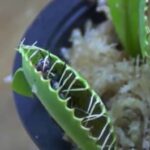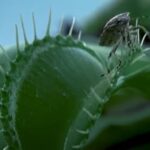As an Amazon Associate, this site earns commissions from qualifying purchases. For more details, click here.
Are the traps of your Venus flytrap too small? Or is the plant itself not growing as large as you expected it to? There are many possible reasons for this. In this guide we will look at the most likely causes and what you can do to speed up growth..
A Venus flytrap that produces small traps is due to lack of sunlight, not enough dormancy or is flowering. Small traps are also common in early spring and will not grow fully until July.
Why Your Venus Flytraps are Small
A healthy Venus flytrap has a diameter of 5 inches and the trap size ranges from 1-2 inches. So even a healthy Venus flytrap is not going to produce a trap large enough to bite you.
It is normal for Venus flytraps to produce small traps in early spring. Some might even appear deformed and that is to be expected. The traps will not grow to full size until mid or late spring.
But if it is past spring and the traps or plant has not grown, there could be problems. Let us look at the possible causes and how to remedy it.
Ready to Grow Carnivorous Plants with Confidence?
Stop guessing and start thriving. Whether you’re raising flytraps, sundews, Nepenthes, or butterworts, this visual-first guide gives you everything you need — from lighting and watering to feeding and seasonal care.
- Beginner-proof diagrams
- Step-by-step routines
- Instant PDF download

Lack of Sunlight
Venus flytraps need 6 to 12 hours of sunshine to grow. If the plant can only have four hours of direct sunshine, it must have access to indirect sunlight for the rest of the day. If you can give it up to 12 hours of sunlight, that is even better.
A Venus flytrap will grow with less than 6 hours of sunlight, but it may not reach its full potential. The plant will survive and produce traps, but they might be smaller than the average.
So if your Venus flytrap looks healthy enough except for the small traps, lack of sun is the most likely cause.
Solution. Make sure your Venus flytrap gets the maximum amount of sunlight possible. This way the plant receives all the nutrients it needs to produce healthy traps. If the plant is indoors, you can use Venoya Grow Lights to provide the lighting.
Venus flytraps should be grown outside where it can receive direct sunlight. As for heat, the plant can handle temperatures above 90 F / 32 C.
Water the soil or shade the plant if the temperature exceeds 110 F / 43 C. If it is over 100 F / 40 C, keep an eye on the plant. Make sure the soil is always wet. This is key to ensuring the traps grow healthy. Venus flytraps will also benefit from nutrients, but they are not insect repellants.
Lack of Dormancy
Venus flytraps need 3 to 5 months of dormancy. Anything less than that will stunt its growth and affect the size of its traps.
The plant goes into dormancy mode when the temperature goes below 50 F / 10 C. Along with shortened daylight, it is a sign for the Venus flytrap to go into dormancy.
During dormancy the traps on a Venus flytrap will cease working. Old leaves are discarded and those that remain will turn brown. This is normal.
Without enough dormancy, a Venus flytrap will not be able to grow to its fullest possible size. Inadequate dormancy is going to shorten its lifespan as well.
Solution. Make sure the Venus flytrap has a dormancy period of 3-5 months or 10 weeks. Do not disturb the plant during this period.
Do not put a Venus flytrap under dim lighting because this might kill it. Outdoors, Venus flytraps will naturally go into a dormant state.
They can handle freezes just fine, but if it is too long this could hurt or kill the plant. So even during winter, you have to light to the plant.
If there is an extended freeze, bring your outdoor Venus flytrap indoors. Make sure to keep the plant damp during dormancy. Do not overwater the plant, just keep it wet. Never leave it dry.
How Long Does It Take For a Venus Flytrap to Fully Grow?
A Venus flytrap takes 2 for 4 years to grow. Fully grown the plant should have a height of 4-5 inches, but others can grow bigger. A healthy trap will be 1 to 1.5 inches. Most Venus flytraps have a 1 inch trap with the exception of the Dionaea B-52 which has 2 inch traps.
If your Venus flytrap size is somewhere in this region it is a sign of good health. But what if it is smaller?
What if the plant has 2 inch leaves but the traps are much smaller, say less than an inch? Is this a bad sign?
First you have to consider the age of your Venus flytrap. If it is less than two years old, the plant has probably not reached its maximum growth potential yet.
The season is another factor. Venus flytraps start shedding leaves in the fall. They do not grow as fast and will become dormant.
As spring arrives the plant starts coming back to life, using the energy it acquired from sunlight. This is why you need to provide light to the plant even when it is dormant.
If growth season just started, it is normal for a Venus flytrap to produce small traps. Give the plant time to flourish again. By June or July the leaves and its traps will reach their full size. This of course assumes the plant is well cared for and had enough dormancy.
How Do I Make My Venus Flytrap Bigger?
Some Venus flytraps grow vertically, while others horizontally. Growth is not straightforward either. During dormancy (winter) the plant stops growing and may even reduce its size. During spring it will recover and grow again. But there are ways to help a Venus flytrap attain bigger traps.
Feed the Venus Flytrap Properly
Indoor Venus flytraps should be fed every 1-4 weeks. You do not have to feed the plant if it is outdoors. Dormant Venus flytraps do not require food.
Venus flytraps can live without eating insects for long periods. Thanks to photosynthesis they can make their own food. But bugs and other foods like Kaytee Mealworms serve as additional sources of nutrients to foster growth.
Indoor Venus flytraps have to be fed. Insects or beta fish pellets along with proper care are essential. If you do these your Venus flytraps will grow healthy.
Only one trap needs to be fed at a time. Give an insect to one trap and that is sufficient for the entire plant. Do not feed it fruits or meat. Outdoor carnivorous plants get plenty of food from sunlight and bugs on their own.
Get a Large Venus Flytrap Variant
The B-52 Venus flytrap variant grows two inch traps, twice the size of other species. No matter how well you take care of the other variants, they cannot reach this size.
If you want the largest flytraps possible, get a B-52 or a Dionaea Girnomous. Both of these will grow large traps provided they are properly taken care of.
Large Venus flytraps need the same care as regular sizes, though they might need more nutrients. But regardless of the size they will need sufficient dormancy and sunlight.
Use the Right Soil and Container
Combine peat moss with perlite or silica sand. You can also use long fiber sphagnum moss instead of peat. Use a 1:1, 4:1 or 2:1 ratio with more moss compared to perlite or sand.
The soil must be free of nutrients for Venus flytraps to grow. These plants usually thrive in soils with little to no nutrients, which is why they learned to adapt and absorb nutrients from insects. If you use rich soil it could actually harm the Venus flytrap and stunt its growth.
The container has to be at least 4 inches (10.16 cm) deep and 5 inches (13 cm) in diameter. As the plant grows, its roots will need more room.
The wider and deeper the pot, the better. You do not have to worry about this if you just planted the Venus flytrap. But as it gets older, you will need to repot it. And do not worry about harming the plant. It might weaken a bit after a repot, but it will soon recover.
Conclusion
All it comes down to is proper care. As long as you nurture your Venus flytrap – plus exercise some patience – you can expect those traps and the plant itself to grow to a healthy size.

My fascination with carnivorous plants began many, many years ago with Venus Fly Traps. Now I am more than happy to impart what I know with other enthusiasts and those who are curious about meat eating plants.



